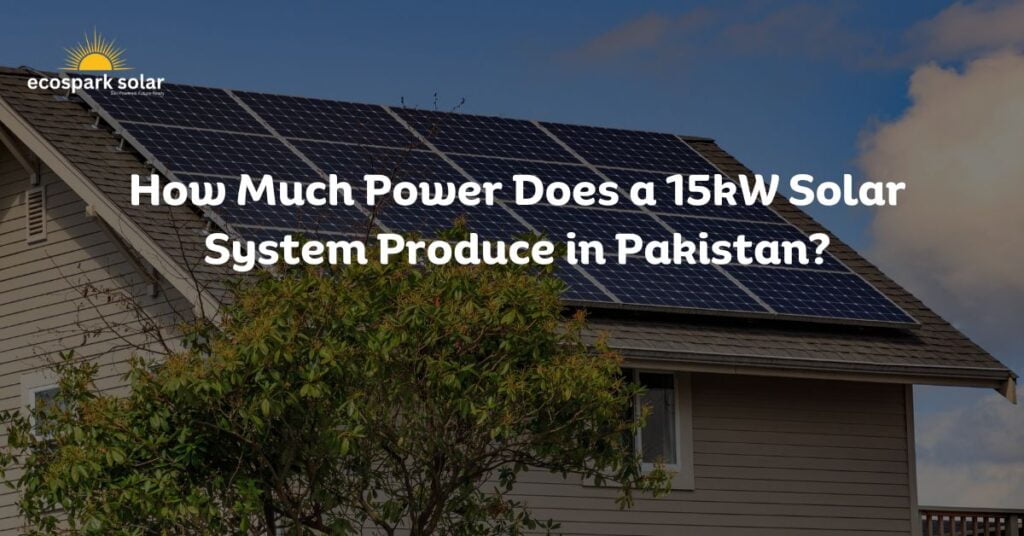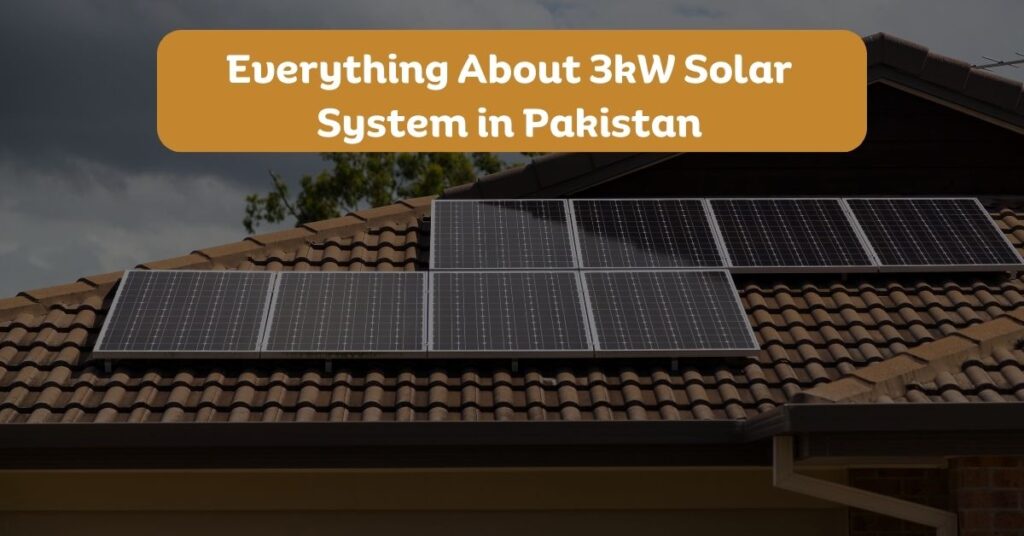15kW solar systems are one of the largest residential solar systems, meant for large homes and medium size businesses. These systems can power essential appliances and a few air conditioners, a water pump, refrigerators, washing machines, and up to 4 LED TVs, among other electrical devices, such as lights and fans.
Since 15kW system would require roughly 30 panels, there must be enough roof space to reasonably accomodate 30 panels.
If you’ve decided to install a 15kW solar system, one of the essential questions you might have is: How much power does a 15kW solar system can produce in Pakistan? Once you know this, you can size your system the right way. And you will know this today in this article.
In the lines below, we will discuss some of the following:
- How to determine the energy output of a 15kW solar system?
- How much power does a 15kW solar system produce in Pakistan?
- Factors influencing the production capacity of a 15kW solar system.
- Electricity production of a 15kW solar system in various cities of Pakistan, including Islamabad, Karachi, Peshawar, Quetta, Lahore, and more.
- How to optimize the energy generation of a 15kW solar system?
Before we calculate the power output, let’s discuss some factors that affect the power generational potential of solar systems. Some of these factors are used in the formula for calculating the solar power output.
Factors Influencing Solar Power Production of 15kW Solar Systems
The power output of a 15kW solar system depends on several factors, which can lead to varying energy production in different locations, even with similar specifications. To give you an accurate picture, we will first discuss those factors. But if you just want the quick answer, scroll below to the section where we have calculated the energy generation of 15kW solar systems.
Solar Irradiation Levels in Your Area
Solar irradiation, also called peak sun hours of a given location is the primary determinant of the power generation capacity of any solar system. In Pakistan, peak sun hours range from 4 to 7 hours per day, making it quite an ideal place for solar power generation.
However, the availability of sunlight can vary based on the season and location within the country. For example, Islamabad receives around 5.5 peak sun hours, while Skardu receives around 3.4. In areas that are more exposed to sunlight, 15kW solar systems would generate more power compared to areas with fewer peak sun hours.
Want to read more on this? Explore our guide to solar hours in Pakistan.
The efficiency of Solar Panels and Inverters
Next, the efficiency. The efficiency of solar panels plays a significant role in determining solar systems’ power production. In Pakistan, the average efficiency of solar panels is approximately 18%, with newer panels offering around 20% efficiency. The more efficient your solar panels are, the more sunlight would it convert into DC electricity.
Speaking of DC electricity, we would need to convert it into AC electricity, for which we use inverters. We recommend high-quality inverters with above 97% efficiency to convert the generated electricity into usable electricity fully.
Solar Array Orientation and Tilt Angle
When many solar panels are combined, we call it a solar array. The orientation and tilt angle of your solar array is another factor that impacts the power production of your 15kW solar system. For optimal results in Pakistan, the ideal orientation for solar panels is south-facing at 180 degrees, while the tilt angle should match the latitude of the installation location, which ranges from 23 to 37 degrees.
In Islamabad, the elevation angle would be around 18-35 degrees—the lower range is for summer, and the higher range for winter. If you want optimal performance throughout the year, it would be around 28 degrees. Proper panel orientation ensures maximum exposure to sunlight throughout the day.
You can read more about how we calculate the direction and elevation angle in this article.
Shading and Obstructions
Next, we have shading and obstructions. Shading from nearby structures, trees, or other obstructions can diminish the power output of solar panels. To maximize energy production, it is important to install panels in areas with minimal shading. Most often, this isn’t in issue in Pakistani homes, so you are good to go.
| You May Want to Know: How Much Does a 15kW Solar System Cost in Pakistan? |
A solar system for everyone.
We’re customer-centric; we will find you a solution within your budget. Whatever your project size, you can always save with Ecospark Solar.
Dust and Debris
Lastly, the accumulation of dust, debris, or bird droppings on solar panels can reduce their sunlight absorption, leading to compromised power generation. Regular cleaning and maintenance of solar panels are essential to ensure optimal performance and maximize energy generation. Read more on cleaning solar panels the right way.

Understanding the Power Production of a 15kW Solar System in Pakistan
Keeping the factors mentioned above, a typical 15kW solar system in Pakistan can generate between 51 and 75 kWh of electricity per day, approximately 1500 to 2250 units per month. This capacity makes a 15kW solar system suitable for powering larger homes or businesses that consume around 1500 to 1800 kWh of electricity monthly. Such a system can easily handle various appliances, including refrigerators, air conditioners, and other electrical equipment.
To calculate the electricity generated by a solar system, the following formula is used:
| Daily production of a solar panel = Solar panel capacity x Peak sun hours x Efficiency factor |
For a 15kW solar system, assuming 5 peak sun hours and an efficiency factor of 0.8, the daily production would be:
| Daily Production of 15kW System = 15,000 watts x 5 x 0.8 = 60 kWh (units) |
Actual power generation may vary depending on factors such as location, weather conditions, and system efficiency. For instance, in areas that receive 6 sun hours, the power produced per day would be 72 kWh (units).
Similarly, the number of units generated could be slightly less in winter. If you want to calculate your monthly production, it is simple. Just multiply the daily production by 30, and you will get it.
| Monthly production of a 15kW solar system = Daily production x 30 = 60 x 30 = 1800 units (kWh) |
Power Generation of a 15kW System in Different Pakistani Cities
The power generation potential of a 15kW solar system may vary slightly across different cities in Pakistan due to variations in solar irradiation levels. Let’s take a look at the power production estimates in the major cities of Pakistan.
How Much Power Does a 15kW Solar System Produce in Islamabad?
In Islamabad/Rawalpindi, a 15kW solar system can generate an average of 66 kWh of electricity per day or approximately 2,000 units per month. With favorable solar conditions and the availability of net metering, Islamabad is an excellent location for solar energy adoption. Additionally, since load shedding is minimal, it makes sense to install an on-grid system.
How Much Power Does a 15kW Solar System Produce in Karachi?
In Karachi, a 15kW solar system can generate an average of 63-72 kWh of electricity per day, translating to 1,890 to 2,160 monthly units. The solar irradiation levels in Karachi align with the national average, making it a promising location for solar power. If your area experiences frequent load shedding, we recommend considering a hybrid solar system.
How Much Power Does a 15kW Solar System Produce in Lahore?
Lahore, similar to Islamabad, can also produce an average of 66-72 kWh of electricity per day with a 15kW solar system. The city benefits from favorable solar conditions, with an average solar irradiation of 5.4 kWh/m2/day. Also, depending on your needs, you may consider installing a hybrid solar system.
How Much Power Does a 15kW Solar System Produce in Peshawar?
A 15kW solar system in Peshawar can generate an average of 66-72 kWh of electricity per day. Peshawar’s average solar irradiation of 5.3 kWh/m2/day makes it an ideal location for solar system installations. For Peshawar, we will recommend a hybrid solar system, as load shedding in some parts may not work well with the on-grid solar system.
How Much Power Does a 15kW Solar System Produce in Quetta?
In Quetta, a 15kW solar system can produce an average of 54-66 kWh of electricity per day. Quetta receives an average solar irradiation of 5.1 kWh/m2/day. During summer, thanks to higher solar irradiation, it can reach higher power generation potential.
Please note that these figures serve as estimates, and actual power generation may vary based on specific factors and seasonal variations in sunlight availability. If you want us to estimate the power generation of a 15kW system for your home, please contact us; we will gladly help you.
What Can You Run with a 15kW Solar System?
A 15kW solar system can power a wide range of appliances in a typical home or medium-sized business. With its higher capacity compared to a 10kW system, a 15kW installation can support more appliances simultaneously.
Some examples of appliances that can be run with a 15kW solar system include:
- Up to 20 fans
- Up to 30 lights
- 3 1.5-ton or 4 1-ton air conditioners (not continuously)
- 2 microwaves
- 1 iron
- 2 refrigerators
- 4 LED TVs
- 1 washing machines
- 3 PCs
And more. The capacity to run these appliances depends on the solar panel’s efficiency, the availability of sunlight in the area, and the appliances’ usage patterns.
Note that you can run even more appliances—just ensure that the instantaneous load doesn’t exceed the instantaneous generation capacity of your solar system.
How to Optimize the Power Output of Your 15kW Solar System?
To optimize the power output of your 15kW solar system, consider the following measures:
- Select high-quality solar panels with higher efficiency ratings. Investing in quality solar panels and avoiding substandard components, such as inverters and switches, will guarantee optimal performance.
- Ensure proper panel orientation and tilt angle. Professional installers can handle this task effectively to maximize sunlight exposure throughout the day.
- Regularly clean and maintain the panels to remove dust or debris, ensuring they operate at their best.
- Monitor system performance to identify any issues or inefficiencies. If you encounter any problems, immediately contact your solar installer, as faulty equipment can affect the entire system’s performance.
- Choose an appropriate installation location to minimize shading. If your solar panel array is exposed to shading, then no matter the efficiency of the solar panels, your system will perform below the recommended line.
How Much Power Does a 15kW Solar System Produce? Wrapping Up
With a 15kW solar system, you can generate 1500 to 2250 units of electricity per month. Given its shorter solar payback period, it is a cost-effective and sustainable solution for larger homes and medium-sized businesses. The higher capacity of a 15kW system allows you to power more appliances and reduce electricity bills significantly while contributing to environmental preservation and enhancing energy independence. If you are considering installing a 15kW solar system for your property, we are here to help you make the most of this clean and renewable energy source.



